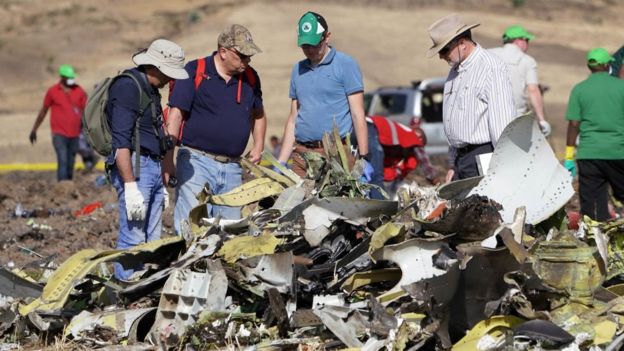The Ethiopian Airlines plane that crashed last month nosedived several times before it hit the ground, a preliminary report has said.
Pilots “repeatedly” followed procedures recommended by Boeing before the crash, according to the first official report into the disaster.
Boeing’s boss has admitted for the first time a failure in the jet’s anti-stall system was a factor in the crash.
Flight ET302 crashed after take-off from Addis Ababa, killing 157 people.
Despite their efforts, pilots “were not able to control the aircraft”, Transport Minister Dagmawit Moges said.
It was the second crash of a Boeing 737 Max aircraft in five months.
Last October, Lion Air flight JT 610 crashed into the sea near Indonesia killing all 189 people on board.
In a news conference in Addis Ababa, Ms Dagmawit said: “The crew performed all the procedures repeatedly [that were] provided by the manufacturer but were not able to control the aircraft.”
The 737 Max family of aircraft was grounded following the Ethiopian Airlines crash, a move affecting more than 300 planes.
What did the report say about the cause of the crash?
The preliminary report did not attribute blame for the crash. But it says the crew were fully qualified to conduct the flight, and that they performed all the expected procedures correctly.
The report goes on to recommend that Boeing review the 737 Max’s “flight control system related to flight controllability” and that aviation regulators ensure this is done before the aircraft goes back into the air.
Crash investigators have focused their attention on the Manoeuvring Characteristics Augmentation System (MCAS) – software designed to help prevent the 737 Max from stalling.
The software reacts when sensors in the nose of the aircraft show the jet is climbing at too steep an angle, which can cause a plane to stall.
The report does not mention the MCAS by name, but it does detail during the minutes after take off the problems the pilots were having in trying to control the aircraft’s angle of flight.
At one point the captain called out three times “pull up”, and seconds after instructed the first officer to tell Air Traffic Control that they had a flight control problem.
In a statement on Thursday, the chief executive of Ethiopian Airlines, Tewolde GebreMariam, said he was “very proud” of the pilots’ “high level of professional performance”.
“It was very unfortunate they could not recover the airplane from the persistence of nosediving,” the airline said in a statement.
What happened to the Lion Air flight?
An investigation into the Lion Air flight suggested the system malfunctioned, and forced the plane’s nose down more than 20 times before it crashed into the sea.
The preliminary report from Indonesian investigators found that a faulty sensor on the aircraft wrongly triggered MCAS without the pilots’ knowledge.
Boeing has been working on an upgrade of the MCAS software since the Lion Air crash.
It has said the system can be disabled – allowing pilots to regain control if there appears to be a problem.
But the latest comments from Ethiopian officials suggest that pilots could not regain control, despite following procedures recommended by Boeing.
Source: BBC




Comments are closed.